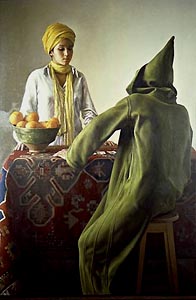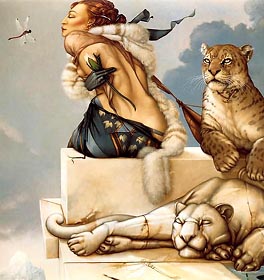|
The Abstract Expressionist movement arrived in the mid
forties and dominated the art world for two decades. In the
sixties, the Postmodern movements began, and several realist
styles emerged. A number of the artists of this period are grouped
as Photorealists. Included are Richard
Estes, Carolyn Brady, Ralph Goings, Robert Bechtle, Audrey Flack,
and the early work from Chuck Close. Photorealism
emphasizes the literal depiction of objects or scenery with no
engagement with the subject matter. An even larger group of realists
in the last four decades are
referred to as Contemporary Realists. Included are William Bailey,
Philip Pearlstein, Janet Fish and Jack Beal . Many in first
generation of these groups
were trained during the reign of Abstract Expressionism, but then choose
to challenge the prevailing attitudes which were opposed to
representational painting. Some of this art seems to create a
virtuality, while other work can be dry, ironic or even satirical
.Many artists have incorporated some
degree of abstraction, flatness or distortion in their paintings to enhanced or
twist literal realism . Others prefer to work toward complete
naturalism and view their art as being in a classical mode. As in
the case of Neue Sachlichkeit, a large number of works focus on the
object . It is easy to find works that have traits in common with
Magic Realism . Postmodern movements began, and several realist
styles emerged. A number of the artists of this period are grouped
as Photorealists. Included are Richard
Estes, Carolyn Brady, Ralph Goings, Robert Bechtle, Audrey Flack,
and the early work from Chuck Close. Photorealism
emphasizes the literal depiction of objects or scenery with no
engagement with the subject matter. An even larger group of realists
in the last four decades are
referred to as Contemporary Realists. Included are William Bailey,
Philip Pearlstein, Janet Fish and Jack Beal . Many in first
generation of these groups
were trained during the reign of Abstract Expressionism, but then choose
to challenge the prevailing attitudes which were opposed to
representational painting. Some of this art seems to create a
virtuality, while other work can be dry, ironic or even satirical
.Many artists have incorporated some
degree of abstraction, flatness or distortion in their paintings to enhanced or
twist literal realism . Others prefer to work toward complete
naturalism and view their art as being in a classical mode. As in
the case of Neue Sachlichkeit, a large number of works focus on the
object . It is easy to find works that have traits in common with
Magic Realism .
Realism in various forms is an important component of a broad evolution in the arts loosely defined as Postmodernism .
In the latter part of the twentieth century, many of the taboos of Modernism
were
shattered. Even classical (i.e. Greco Roman) subject matter has
again become acceptable, without the label of being regressive. In the Postmodern world art is pluralistic
and global in scope. It is often subjective and may be outright eclectic.
Many artists employ early Modern styles or pre-Modern styles
interchangeably, drawing references from other periods in art
history.
Many Magic Realists looked to the art of the Old Masters with
admiration. But although they borrowed from them technically, the
 subject matter of their work
was always contemporary. Their
art represents perhaps the first "anti-avantgarde" movement, but it
still is a type of Modern art. Today the heyday of avant-garde
art has past, and new directions are unclear. At the same time, the
renewed interest in the techniques of the Old Masters by a large number of
artists makes a statement about the ties of art to the traditions of
craftsmanship. subject matter of their work
was always contemporary. Their
art represents perhaps the first "anti-avantgarde" movement, but it
still is a type of Modern art. Today the heyday of avant-garde
art has past, and new directions are unclear. At the same time, the
renewed interest in the techniques of the Old Masters by a large number of
artists makes a statement about the ties of art to the traditions of
craftsmanship.
One of the challenges for the art historian is to help us understand
the social factors that contribute to the development of art . Each
generation of artists is motivated by unique personal and cultural
experiences which can never again be duplicated. In the 1920's and
30's, these experiences were still very regionalized. Today, with
mass media, fast communication and accessibility, the world is of
course quite different. Art today often finds relevancy by accepting
or embracing technology or popular culture. Still the artist who
uses Magic Realism as a platform
can bring us a new experience of the world we live in, one which
transcends the present, becoming timeless.


Neue Sachlichkeit Gallery
European Magic
Realism Gallery
America Magic Realism
Gallery
Chapter 1 - Magic Realism Introduction
Chapter 2 - Roots of Magic Realism
Chapter 3 - Neue Sachlichkeit Artists
Chapter 4 - Surrealism vs Magic Realism
Chapter 5 - Magic Realism in other European
countries
Chapter 6 - Magic Realism in the Americas
(1)
Chapter 7 - Magic Realism in the
Americas (2)
Chapter 9 - The Future of Magic Realism
Email:
info@tendreams.org
|